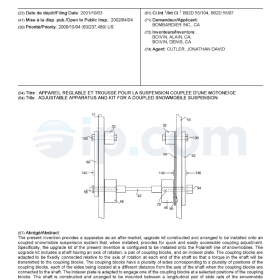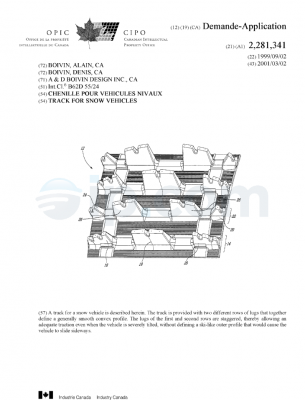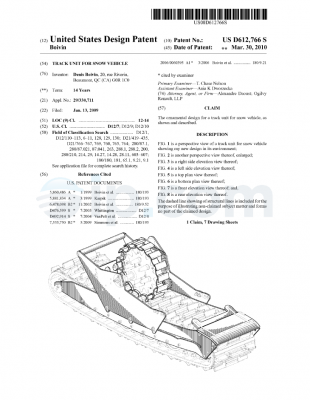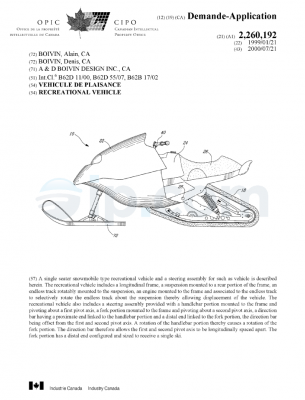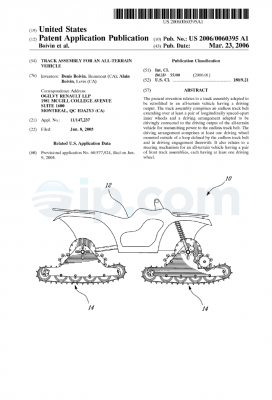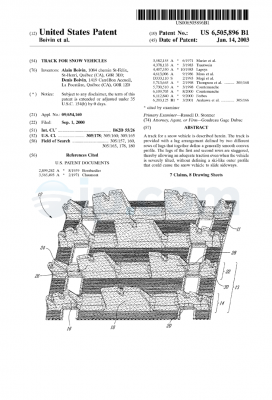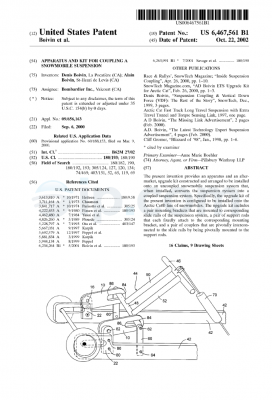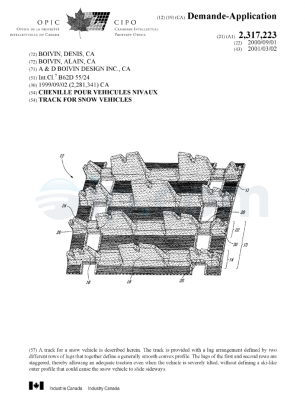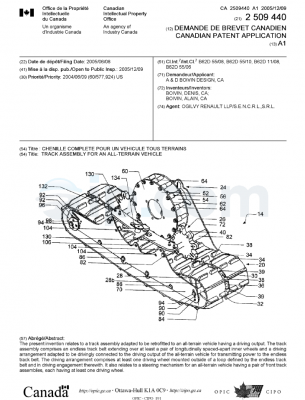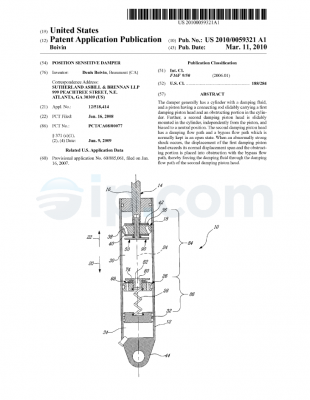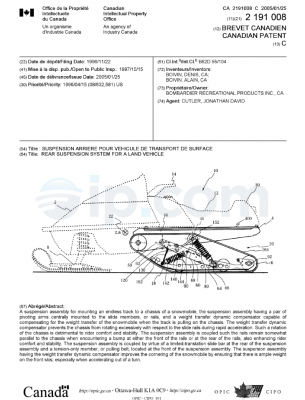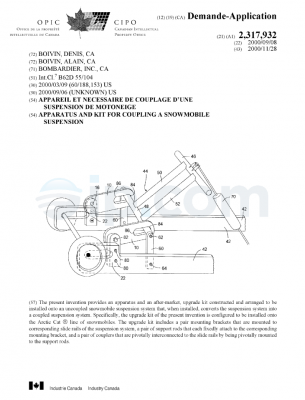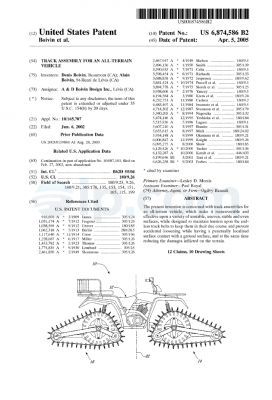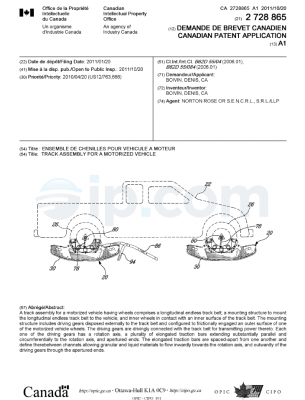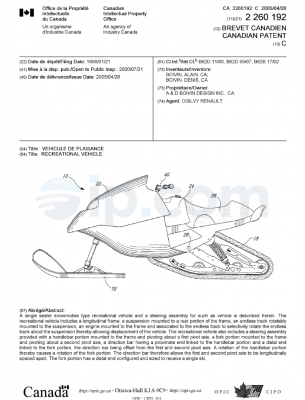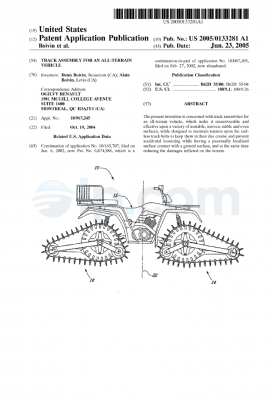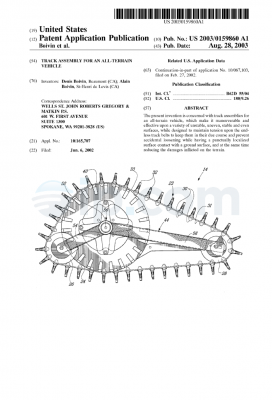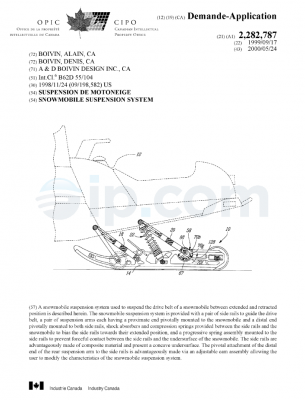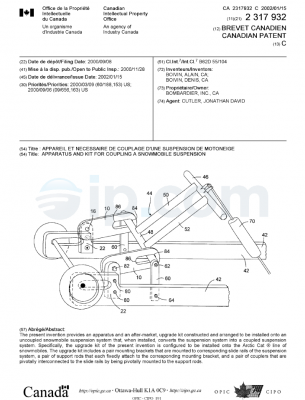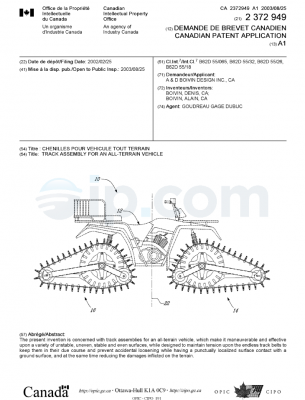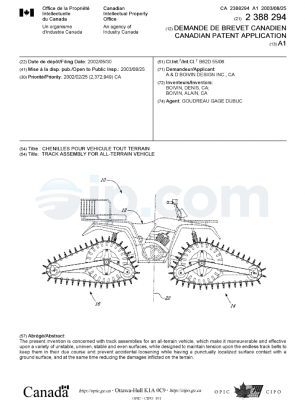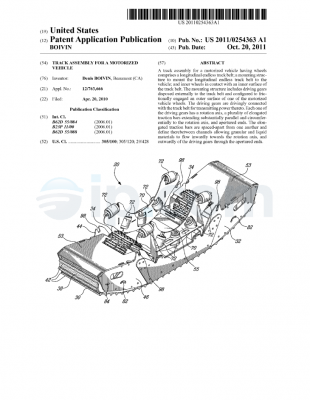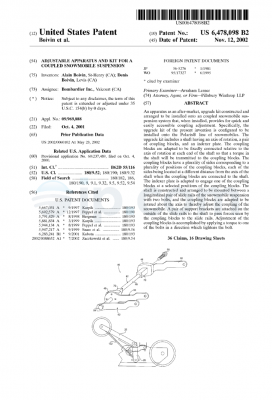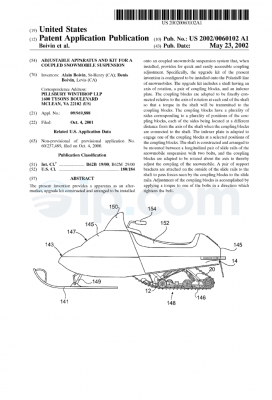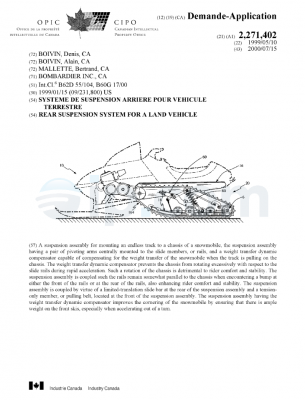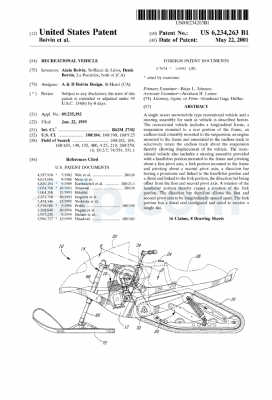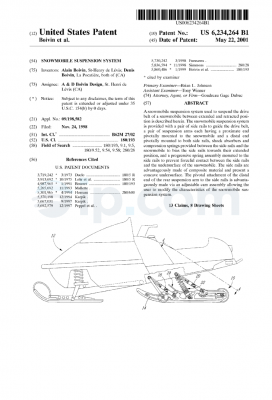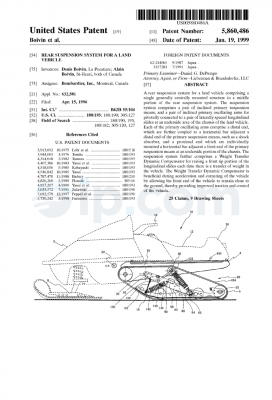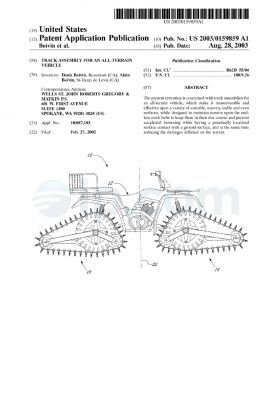CA 02358154 2001-10-03
may be integrally formed with the main shaft 42 (see Fig. 6C). That is, the
main shaft 42 would
comprise coupler blocks 46, 48 integrally formed at each end of the main
shaft. In such case, the
rectangular portions 70, 72 for transmitting torque to the coupling blocks
would not be required.
Whether integrally formed or as a separate structure, each coupler block 46,
48 in the
preferred embodiment includes a plurality of sides corresponding to a
plurality of positions of the
coupling blocks. In the preferred embodiment, the coupling blocks 46, 48
include four sides 84, 85,
86, 87 that are each located at a different distance from the axis 74 when the
coupling blocks are
connected to the main shaft 42. As shown in Fig. 9 for clarity, each side 84,
85, 86, and 87 is
located a distance « d5 », « d6 », « d7 », and « d8 », respectively, from the center
rectangular bore 80 (or,
equivalently, the axis 74 of the main shaft 42). Adjustment of the coupling
system after the upgrade
kit 40 is installed onto the snowmobile suspension system is accomplished by
rotating the coupling
blocks 46, 48 so that the desired side is selected for use (i.e., to engage
surface 27 of lower pivot
arm 26, shown in Fig. 3), which is discussed in detail below.
In the preferred embodiment where the coupling blocks are separate structures
from the
main shaft, the adjuster blocks 46, 48 are made of ultra high molecular weight
(UHMW) plastic,
which is chosen for its light weight but high strength, rigidity, and superior
wear characteristics.
However, it will be understood to those skilled in the art that other suitable
materials could also be
used, such as steel alloy. If the coupling blocks are integrally formed with
the main shaft 42, then,
of course, the coupling block material would be the same as the main shaft
material.
In the preferred embodiment, at least one of the coupling blocks 46, 48
includes a cylindrical
bore 82 formed therethrough, and a ball spring plunger 90 is inserted therein,
as shown in Figs. 10
and 11. The ball spring plunger 90 acts as an index stopping « pointer » or
protrusion for indexing the
coupling blocks 46, 48 at a selected position in conjunction with indexer
plate 50, which will be
9
CA 02358154 2001-10-03
described below. The ball spring plunger 90 is of the conventional type, and
generally includes a
protrusion or ball 96 resiliently disposed, by a spring 97, against an
interior edge of flange stop 94.
The spring 97 is disposed within a cylindrical chamber defined by cylindrical
walls 92, the diameter
of which is slightly larger than the rectangular bore 80 so that the ball
spring plunger 90
interferingly fits within bore 80.
Although a ball spring plunger 90 is used in the preferred embodiment, it will
be understood
by those skilled in the art that other mechanisms can also be used to perform
indexing of coupling
blocks 46, 48, such as, for example, a resilient cantilever spring 98 formed
with a protrusion or ball
99, shown in Fig. 12, or a bevel spring 100 formed with a protrusion or ball
101, as shown in Fig.
13.
Indexer plate 50, shown separately in Fig. 14, has a through-hole 106 formed
therethrough at
one end and a through-hole 108 formed therethrough at its other end, which is
also located
approximately centrally of a generally circular portion 110 of indexer plate
50. Four equally
spaced-apart through bores 112, 114, 116, 118 are formed toward the periphery
of circular portion
110 in surrounding location of through-hole 108, and all the holes are located
at the same radial
distance from the center of through-hole 108. When the upgrade kit is
installed onto the
snowmobile, through-hole 108 receives bolt 54 for positioning the indexer
plate 50 relative to the
coupling blocks (bolt 54, along with bolt 58, also pivotally mounts the main
shaft 42 to the slide
rai1s10), and one of the holes (i.e., either bore 112, 114, 116, or 118) is
aligned and engaged with the
ball spring plunger 90 to establish a position of the coupling blocks 46, 48.
Through-holes 112,
114, 116, and 118 may also be depressions in the indexer plate of sufficient
size to sufficiently
engage the protrusion or ball 96 of the ball spring plunger 90. The other end
of indexer plate 50 is
bolted via through-hole 106 to the slide rail 10 of the snowmobile to thereby
fixedly define the
CA 02358154 2001-10-03
position of the four holes 112, 114, 116, 118 with respect to the coupling
blocks 46, 48. The
distance between the center of holes 106 and 108 is designated as L11. The
indexer plate 50 is
preferably made of brass plate having a thickness of 0.074 inches. However,
any other suitable
material and appropriate thickness could also be used.
Although in the preferred embodiment a protrusion is mounted to one of the
coupling blocks
for engagement with a depression (or hole) of the indexer plate, it is
contemplated that the indexer
plate 50, rather than the coupling blocks 46, 48, may mount the protrusions.
That is, as shown in
Fig. 13B, the ball spring plunger 90 may be mounted to indexer plate 50 for
engagement with a
plurality of depressions or bores 109 formed in one of the coupling blocks
(see Fig. 13B).
Each plate bracket 62, 66, shown separately in Fig. 15, defines two through-
holes 122, 124
formed therethrough at each end therein. The size and proximity of the through-
holes 122, 124
correspond with the through-holes 106, 108 of indexer plate 50. Thus, the
distance, L12, between
through-holes 122 and 124 is substantially the same as the distance L11.
Through-hole 124 of plate
bracket 62 receives bolt 54, which also is received by through-hole 108 of
indexer plate 50, and
through-hole 124 of plate bracket 66 receives bolt 58, as shown in the
assembly drawing of Fig. 5.
Through-hole 122 and through-hole 106 receives another bolt 130 (see Fig. 19),
thus fixedly
mounting both the plate bracket 62 and the indexer plate to the slide rail 10
(discussed below). Plate
bracket 66 of the opposite side of the snowmobile is likewise fixed to the
slide rail, but without an
indexer plate. The plate brackets 62, 66 provide support between the coupling
blocks 46, 48 and the
slide rail 10. That is, the brackets 62, 66 pass forces seen by the coupler
system (when, for example,
the lower arm 62 is urged against coupling blocks 46, 48) to the slide rails,
which are made of
aluminum. Because they are designed to carry stress, the plate brackets 62, 66
are preferably made
of 3/16″ brass plate. However, it will be understood to those skilled in the
art that the thickness or
11
CA 02358154 2001-10-03
material used is not intended to be limiting, and that other materials and/or
thicknesses can be used
as long as the combination selected is sufficiently strong and rigid.
Refernng now to Figs. 16-20, the components of the upgrade kit 40 described
above are
constructed and arranged to be assembled and attached to the slide rails 10 of
a coupled snowmobile
suspension system. More specifically, upgrade kit 40 is configured to be
assembled onto a Polaris~
snowmobile suspension system of the type which is generally depicted, without
the upgrade kit 40
attached, in Figs. 1-4. Even more specifically, the upgrade kit 40 is
configured to be assembled
onto the Polaris~ XTRA-10 snowmobile suspension system, which is depicted in
Figs. 16 and 17.
As seen in Figs. 16 and 17 of the XTRA-10 model, the coupler block 30, rear
stop 32, lower pivot
arm 26, are slightly modified from the Polaris~ model shown in Figs. 1-4. The
differences,
however, are not substantial, so the same reference numerals are used for
equivalent elements.
Generally, the suspension system of the Polaris~ snowmobile includes a slide
frame 13,
which comprises a pair of laterally spaced apart slide rails 10 or
longitudinal skids interconnected
transversely on opposing lateral sides of the machine. The slide frame 13 is
interconnected to the
snowmobile chassis 14 by a front and rear suspension arm, 12 and 20,
respectively. As more clearly
seen in Fig. 17, each coupling block 30 is mounted to the slide rails 10 with
bolts 126, and each rear
stop 32 is mounted to the slide rails 10 with bolts 128. As discussed above
and described in the
‘579 patent, the lower pivot arm 26 can rotate within the limits defined by
rear surface 31 of the
front adjuster block 30 and rear stop 32. The remainder of the suspension
system is known in the art
and described in the ‘579 patent, and therefore need not be described in
detail.
Referring now to Figs. 18 and 19, the attachment of upgrade kit 40 to the
Polaris~
suspension system will now be described. First, after raising and supporting
the suspension off the
ground, the bolts 126 and 128, which mount adjuster blocks 30 and rear stop
32, are removed. The
12
CA 02358154 2001-10-03
adjuster blocks 30 are then removed from the slide rails 10. Then, after
mounting the coupling
blocks 46, 48 of the upgrade kit 40 to the rectangular portions 70, 72 of main
shaft 42, the assembly
is installed so that coupling blocks 46, 48 replace the original blocks 30.
The main shaft assembly
(i.e., main shaft 42 and blocks 46, 48) is disposed on the inner side of the
slide rails 10 (see Fig. 19).
The indexer plate 50 is then inserted between adjuster block 48 (i.e., the
block that contains
the ball spring plunger 90) and a slide rail 10 on one side of the snowmobile
suspension. Through-
hole 108 of indexer plate 50 is aligned with threaded hole 72 of main shaft
42, and through-hole 106
is aligned with the mounting position of rear stop 32. The two plate brackets
62, 66 are then
installed on the outside of the slide rails 10, with through-holes 124, 122 of
each plate bracket
aligned with the threaded holes of the main shaft 42 and the m~unting
positions of each rear stop 32.
Bolts 54 and 58 are then put in place, but not fully tightened, in order to
retain the main shaft 42, the
indexer plate 50, and the plate brackets 62, 66. The original rear stop 32
mounting bolts 128 are
replaced with longer bolts 130 (preferably 1 1/2 x 318 NC bolts with a nylon
nut) and the rear stops
32 are rebolted, joining together the indexer plate 50, the slide rail 10, and
the plate brackets 62, 66.
Bolts 54 and 58 are then tightened for complete installation of the upgrade
kit 40. Preferably, a
torque of 400 in-lb is applied to bolt 54. If a limiter strap 132 is used in
the suspension system, it is
disposed below the main shaft 42, as shown in Fig. 18. Also, bolts 54 and 58
are preferably not
threaded over the entire length of the bolt. Rather, the portion of the bolts
extending beyond the
coupling blocks 46, 48 after installation have smooth surfaces for
rotationally sliding contact with
the indexer plate, slide rails, and support plates.
A top view of the installed upgrade kit 40 is shown in Fig. 19. As seen, when
the assembly
is installed and tightened, a side of the coupling blocks 48 and 46 for
engagement with surface 27 of
arm 26 (see solid line in Fig. 20) is initially chosen and the ball of plunger
90 corresponds with and
13
CA 02358154 2001-10-03
is disposed within a hole (either bore 112, 114, 116, or 118) of the index
bracket 50. After
installation and the indexer plate 50 and coupling block 48 are engaged, a
small gap 136, or
clearance, exists between block 48, with indexer plate disposed in contiguous
relation with the ball
spring plunger’s 90 collar. Also, in the preferred embodiment, axial
clearances 138, 140 remain
between the head of bolts 54 and 58 and the support plates 62 and 66,
respectively, after the bolts
are completely tightened (i.e., bottomed-out in bores 78) to the upgrade kit
40. These clearances
138, 140 permit the coupling blocks 46, 48 to easily rotate when adjusting the
coupling blocks,
discussed below.
To adjust the coupling blocks 46, 48 so that a different side engages surface
27 of lower
pivot arm 26, a torque is applied to bolt 54 in the clockwise direction, as
shown in Fig. 20. Since
this torque further tightens bolt 54 and bolt 54 has already bottomed-out in
bores 78, the applied
torque is transmitted to and causes the main shaft 42 and coupling blocks 46,
48 to rotate clockwise.
As torque is applied to the bolt 54, the ball 96 is compressed inward of
plunger 90 and forced out of
the hole of the indexer plate 50. When enough rotation is effected so that
ball 96 « f nds » the next
hole in the indexer plate 50, the ball again springs into engagement with the
indexer plate to prevent
further rotation of the adjuster blocks 46, 48. This process is repeated until
the desired coupling
block side (i.e., either side 84, 85, 86, or 87 (Fig. 9)) is in position to
engage surface 27 of arm 26,
shown as dotted lines Fig. 20.
The upgrade kit 40 of the present invention thus allows a quick and easy means
to adjust the
coupler of the Polaris~ snowmobile. As originally manufactured, the rider had
to first loosen the
central mounting bolt 126. Then the rider had to, either with his fingers or
with the aid of another
tool, rotate block 30 to the desired location, and then retighten the central
mounting bolt 126. The
rider had to then repeat these steps for the adjuster block on the opposite
slide rail. With the
14
CA 02358154 2001-10-03
upgrade kit 40 installed, however, the rider only needs to perform a single
step, which is to rotate
bolt 54 clockwise with a suitable tool until the desired side of coupling
blocks 46, 48 are in position.
Notably, no loosening of the system is required, and no further tightening is
required once the desire
coupling block side for engagement with surface 27 is in position. The ball
plunger’s 90
engagement with indexer plate 50 prevents further rotation of the adjuster
blocks without the need
to further tighten bolts 54 or 58. This allows the rider the ability to
quickly and easily adjust the
coupling of the suspension for varying terrain conditions. Furthermore, the
head of bolt 54 is
preferably sized to accommodate a conventional spark-plug wrench. Thus, the
rider, who typically
akeady carnes a spark-plug wrench when riding the snowmobile, need not bring
an additional tool
in order to make a coupling adjustment in the field.
Though not intended to be limiting, the dimensions of the components of
upgrade kit 5,
which are sized for the Polaris~ XTRA-10 snowmobile suspension, are the
following:
Table 1: Dimensions of upgrade kit 40 components.
Main Shaft 42 (Fig.dimension (inches)
6)
L1 8.468
L2 2.250
L3 1.000
D 1 0.500
D2 0.900
Coupling blocks 46, 48 (Figs. 7 and 8)
L4 1.656
L5 1.988
L6 0.750
L7 0.750
15
CA 02358154 2001-10-03
Lg 0.475
L9 0.344
L 10 1.000
Rl 0.750
R2 0.500
R3 0.375
R4 0.500
Indexer plate 50 (Fig. 14)
L11 3.741
D4 0.375
DS 0.265
D6 0.395
RS 1.000
Plate brackets 62, 66 (Fig. 14)
L12 3.741
D7 0.394
D8 0.375
Although the upgrade kit 40 with the above dimensions is intended for the
Polaris~ XTRA-
snowmobile, the dimensions of the components above can be modified to fit the
following
Polaris~ models: the STORM series (model years 1996-98); the STORM SE series
(year 1997); the
800 XCR series (model years 1999-2001); the XCR, XC, XCR SP, and XCR SE series
(model years
1996-2000), but excluding the 440 cc XCR, XC, and XC DELUXE models; the XC SP
(model
years 1999-2000); the ULTRA SPX and SPX SE series (model year 1997); the INDY
XLT series
(model year 1997); the INDY XCF (model year 1997-99); the INDY XLT Special
(model year
1998-99); the INDY 440 and 500 (model year 1996-1999); the INDY SUPER SPORT
series (model
year 1996-2000); the INDY TRAIL (model year 1996-99); and the INDY TRIUMPH
(model year
16


 English
English